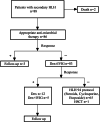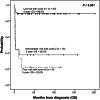Treatment outcomes and prognostic factors for non- malignancy associated secondary hemophagocytic lymphohistiocytosis in children
- PMID: 32517812
- PMCID: PMC7281941
- DOI: 10.1186/s12887-020-02178-7
Treatment outcomes and prognostic factors for non- malignancy associated secondary hemophagocytic lymphohistiocytosis in children
Abstract
Background: Secondary hemophagocytic lymphohistiocytosis (HLH) is a rare hyperinflammatory syndrome that requires prompt diagnosis and appropriate treatment. A risk-stratification model that could be used to identify high-risk pediatric patients with HLH who should be considered for second-line therapies, including salvage regimens and allogeneic hematopoietic cell transplantation (HCT), was developed.
Methods: The medical records of 88 pediatric patients (median age 1.4 years, range 0.2-15 years) with non-malignancy associated secondary HLH were retrospectively reviewed. Treatment strategies included dexamethasone, etoposide, and cyclosporine.
Results: Survival analysis showed HLH patients with infections other than Epstein-Barr virus (EBV) and unknown causes experienced better 5-year overall survival (OS) than patients with HLH due to autoimmune disease, EBV or immunodeficiency (76% vs. 65, 33.3, 11%, p < 0.001). On multivariate analysis, among all patients, non-response at 8 weeks was the most powerful predictor of poor OS. When treatment response was excluded, hemoglobin < 60 g/L and albumin < 25 g/L at diagnosis were associated with poor OS. In patients with EBV-HLH, hemoglobin < 60 g/L at diagnosis was associated with poor OS. A prognostic risk score was established and weighted based on hazard ratios calculated for three parameters measured at diagnosis: hemoglobin < 60 g/L (2 points), platelets < 30 × 109/L (1 point), albumin < 25 g/L (2 points). Five-year OS of low-risk (score 0-1), intermediate-risk (score 2), and poor-risk (score ≥ 3) patients were 88, 38, and 22%, respectively (p < 0.001).
Conclusions: These findings indicate that clinicians should be aware of predictive factors at diagnosis and consider 8-week treatment response to identify patients with high-risk of disease progression and the need for second-line therapy and allogeneic HCT.
Keywords: Hemophagocytic lymphohistiocytosis; Prognostic factor, risk stratification.
Conflict of interest statement
The authors declare that they have no competing interests.
Figures



Similar articles
-
Malignancy-associated hemophagocytic lymphohistiocytosis in children: a 10-year experience of a single pediatric hematology center.Hematology. 2020 Dec;25(1):389-399. doi: 10.1080/16078454.2020.1833505. Hematology. 2020. PMID: 33161882 Clinical Trial.
-
Virus-triggered secondary hemophagocytic lymphohistiocytosis.Acta Paediatr. 2021 Oct;110(10):2729-2736. doi: 10.1111/apa.15973. Epub 2021 Jun 22. Acta Paediatr. 2021. PMID: 34096649 Review.
-
[Clinical analysis and follow-up study of Epstein-Barr virus associated-hemophagocytic lymphohistiocytosis in childhood].Zhonghua Er Ke Za Zhi. 2010 Feb;48(2):121-6. Zhonghua Er Ke Za Zhi. 2010. PMID: 20426937 Chinese.
-
T Cell-Epstein-Barr Virus-Associated Hemophagocytic Lymphohistiocytosis (HLH) Occurs in Non-Asians and Is Associated with a T Cell Activation State that Is Comparable to Primary HLH.J Clin Immunol. 2021 Oct;41(7):1582-1596. doi: 10.1007/s10875-021-01073-9. Epub 2021 Jun 26. J Clin Immunol. 2021. PMID: 34173902 Free PMC article.
-
Haemophagocytic lymphohistiocytosis and Epstein-Barr virus: a complex relationship with diverse origins, expression and outcomes.Br J Haematol. 2022 Jan;196(1):31-44. doi: 10.1111/bjh.17638. Epub 2021 Jun 24. Br J Haematol. 2022. PMID: 34169507 Review.
Cited by
-
Central nervous system involvement and thrombocytopenia as predictors of mortality in children with hemophagocytic lymphohistiocytosis.Front Pediatr. 2022 Sep 6;10:941318. doi: 10.3389/fped.2022.941318. eCollection 2022. Front Pediatr. 2022. PMID: 36147804 Free PMC article.
-
Hemophagocytic lymphohistiocytosis in a child with human immunodeficiency virus infection - a case report.Rom J Morphol Embryol. 2021 Jan-Mar;62(1):279-282. doi: 10.47162/RJME.62.1.29. Rom J Morphol Embryol. 2021. PMID: 34609432 Free PMC article.
-
Hemophagocytic Lymphohistiocytosis as Initial Presentation of Malignancy in Pediatric Patients: Rare but Not to Be Ignored.Children (Basel). 2021 Nov 24;8(12):1083. doi: 10.3390/children8121083. Children (Basel). 2021. PMID: 34943279 Free PMC article.
-
A convenient and practical index for predicting the induction response in adult patients with hemophagocytic lymphohistiocytosis: ferritin/platelet ratio.Ann Hematol. 2024 Mar;103(3):715-723. doi: 10.1007/s00277-023-05606-7. Epub 2024 Jan 10. Ann Hematol. 2024. PMID: 38197929 Free PMC article. Review.
-
Crimean-Congo Hemorrhagic Fever Virus for Clinicians-Epidemiology, Clinical Manifestations, and Prevention.Emerg Infect Dis. 2024 May;30(5):854-863. doi: 10.3201/eid3005.231647. Emerg Infect Dis. 2024. PMID: 38666548 Free PMC article. Review.
References
-
- Janka GE, Lehmberg K. Hemophagocytic syndromes. Blood Rev. 2014;28(4):135–142. - PubMed
-
- Janka GE. Familial and acquired Hemophagocytic Lymphohistiocytosis. Annu Rev Med. 2012;63:233–246. - PubMed
-
- Kleynberg RL, Schiller GJ. Secondary hemophagocytic lymphohistiocytosis in adults: an update on diagnosis and therapy. Clin Adv Hematol Oncol. 2012;10(11):726–732. - PubMed
-
- Apodaca E, Rodríguez-Rodríguez S, Tuna-Aguilar EJ, et al. Prognostic factors and outcomes in adults with secondary Hemophagocytic Lymphohistiocytosis: a single-center experience. Clin Lymphoma Myeloma Leuk. 2018;18(10):e373–e380. - PubMed
MeSH terms
Supplementary concepts
LinkOut - more resources
Full Text Sources
Medical
Molecular Biology Databases

